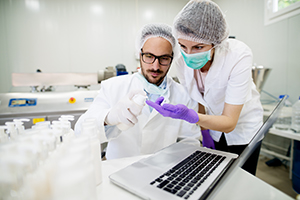 The global demand for sanitizing products has surged, driven by heightened awareness of hygiene and health safety, particularly in the wake of the COVID-19 pandemic. As consumer expectations evolve, so too do the trends and regulatory requirements surrounding the formulation of sanitizing products. Here’s an overview of the latest trends and the regulatory landscape affecting chemists and manufacturers in this field.
The global demand for sanitizing products has surged, driven by heightened awareness of hygiene and health safety, particularly in the wake of the COVID-19 pandemic. As consumer expectations evolve, so too do the trends and regulatory requirements surrounding the formulation of sanitizing products. Here’s an overview of the latest trends and the regulatory landscape affecting chemists and manufacturers in this field.
Current Trends in Sanitizing Products
- Natural and Eco-Friendly Formulations
Consumers are increasingly seeking products that are both effective and environmentally friendly. This has led to a rise in the formulation of natural sanitizers, which utilize plant-based ingredients and biodegradable components. Brands are highlighting their sustainability credentials, focusing on eco-certifications and packaging innovations that reduce plastic waste.
- Multi-Functional Products
There’s a growing preference for multi-functional sanitizing products that not only disinfect but also clean and provide other benefits. For example, products that combine sanitizing properties with surface cleaning, deodorizing, or antimicrobial action are gaining traction, as consumers seek convenience and efficiency.
- Formulation Transparency
Consumers are becoming more informed about the ingredients in sanitizing products, leading to a demand for transparency. Brands that clearly list their active ingredients and provide information on sourcing, safety, and efficacy are favored. This trend is accompanied by the use of straightforward labeling, making it easier for consumers to make informed choices.
- Enhanced Efficacy Claims
With the emergence of new pathogens and variants, the efficacy of sanitizing products has become a key selling point. Formulators are focusing on improving performance against a broader spectrum of microorganisms, including bacteria, viruses, and fungi. Robust testing and certification are critical to support these claims.
Gain the ingredient insights you need with Prospector Premium. Learn more here!
- Innovative Delivery Systems
Technological advancements are leading to innovative delivery systems for sanitizing products. For instance, the use of aerosols, wipes, and foams is becoming popular, offering targeted application and ease of use. Spray technologies that enhance coverage and reduce waste are also on the rise.
Regulatory Landscape
- Increased Scrutiny and Standards
Regulatory agencies worldwide have tightened scrutiny of sanitizing products, especially in light of the pandemic. In the U.S., the Environmental Protection Agency (EPA) has established specific criteria for sanitizers and disinfectants. Manufacturers must demonstrate efficacy through approved testing methods and provide comprehensive labeling.
- Emerging Biocidal Regulations
In regions like the European Union, the Biocidal Products Regulation (BPR) mandates that all biocidal products, including sanitizers, undergo rigorous assessment before they can be marketed. This includes demonstrating the safety and efficacy of active ingredients, which can lead to longer approval times for new formulations.
- Sustainability Regulations
Regulatory bodies are increasingly focusing on sustainability, prompting manufacturers to consider environmental impacts in their formulations. For example, the EU’s Green Deal emphasizes reducing the carbon footprint and ensuring chemical safety, which will influence future formulations and sourcing of raw materials.
- Consumer Product Safety Standards
In addition to environmental regulations, manufacturers must comply with consumer safety standards, which vary by region. For example, the Consumer Product Safety Commission (CPSC) in the U.S. oversees the safety of consumer products, including sanitizers, ensuring they are safe for use in homes.
- Global Harmonization Efforts
There is a growing movement towards harmonizing regulations across countries to simplify compliance for manufacturers. Initiatives such as the Globally Harmonized System (GHS) aim to standardize labeling and safety data, which can facilitate international trade and streamline the regulatory process for sanitizing products.
Access compliance data that helps you drive smart business decisions and manage product compliance across your entire retail ecosystem. Learn more here!
Conclusion
The landscape for formulating sanitizing products is dynamic, influenced by consumer preferences for safety, efficacy, and sustainability, alongside evolving regulatory requirements. Chemists and manufacturers must stay abreast of these trends and regulations to create products that not only meet market demands but also comply with stringent safety standards. As the focus on hygiene continues, the sanitizing product market is likely to evolve further, presenting both challenges and opportunities for innovation.
The views, opinions and technical analyses presented here are those of the author or advertiser, and are not necessarily those of ULProspector.com or UL Solutions. The appearance of this content in the UL Prospector Knowledge Center does not constitute an endorsement by UL Solutions or its affiliates.
All content is subject to copyright and may not be reproduced without prior authorization from UL Solutions or the content author.
The content has been made available for informational and educational purposes only. While the editors of this site may verify the accuracy of its content from time to time, we assume no responsibility for errors made by the author, editorial staff or any other contributor.
UL Solutions does not make any representations or warranties with respect to the accuracy, applicability, fitness or completeness of the content. UL Solutions does not warrant the performance, effectiveness or applicability of sites listed or linked to in any content.
